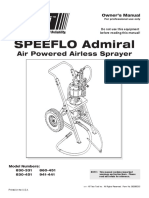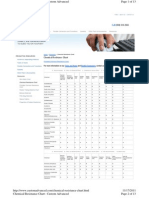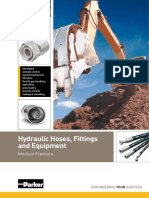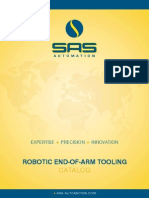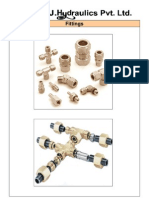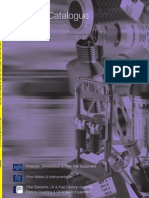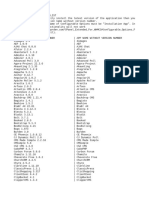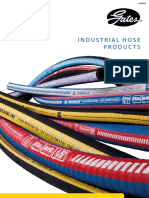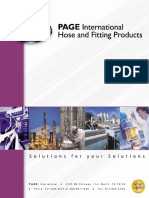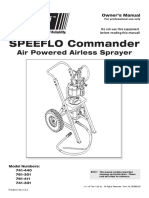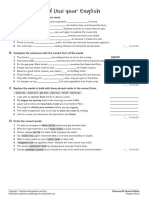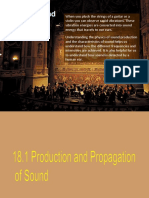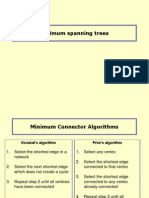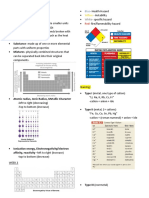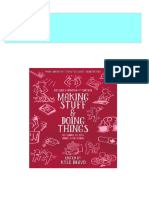Spray Gun Maintenance and Troubleshooting Guide (JGA) : Warning
Spray Gun Maintenance and Troubleshooting Guide (JGA) : Warning
Uploaded by
popCopyright:
Available Formats
Spray Gun Maintenance and Troubleshooting Guide (JGA) : Warning
Spray Gun Maintenance and Troubleshooting Guide (JGA) : Warning
Uploaded by
popOriginal Description:
Original Title
Copyright
Available Formats
Share this document
Did you find this document useful?
Is this content inappropriate?
Copyright:
Available Formats
Spray Gun Maintenance and Troubleshooting Guide (JGA) : Warning
Spray Gun Maintenance and Troubleshooting Guide (JGA) : Warning
Uploaded by
popCopyright:
Available Formats
MAINTENANCE & TROUBLESHOOTING PAGE 1
Spray gun Maintenance and
Troubleshooting Guide
(JGA)
IMPORTANT: Before using the gun for the first time, tighten the needle
packing until the needle starts to bind. Then loosen the packing nut just
WARNING enough so that the needle moves freely.
The following hazards may occur during the normal use of this equipment. Please read the
following chart before using the equipment.
Area Hazard Safeguard
Tells where hazards may occur. Tells where hazard is. Tells how to avoid the hazard
Spray Area- Solvent and coatings can be highly Adequate exhaust must be provided to
Fire Hazard flammable or combustible especially keep air free of accumulations of flammable
when sprayed. vapours.
Smoking must never be allowed in the
spray area.
Fire extinguishing equipment must be
present in the spray area.
Solvent Spray During cleaning and flushing, solvents Wear eye protection
can be forcefully expelled from fluid and
air passageways. Some solvents can
cause eye injury.
Toxic Substances Certain materials may be harmful if Follow the requirements of the Material
inhaled, or if there is contact with the Safety Data Sheet supplied by your coating
skin. material manufacturer.
Adequate exhaust must be provided to
keep the air free of accumulations of toxic
materials.
Use a mask or respirator whenever there is
a chance of inhaling sprayed materials.
This mask must be compatible with the
material being sprayed and its
concentration.
Explosion Hazard- Halogenated Hydrocarbon solvents - for Guns with stainless steel fluid passages
Incompatible Materials example: Methylene Chloride and 1,1,1 - may be used with these solvents. However,
Trichloroethane are not chemically Aluminium is widely used in other spray
compatible with the aluminium which may application equipment - such as material
be used in many system components. pumps, cups and regulators, valves, etc.
The chemical reaction caused by these Check all other equipment items before use
solvents reacting with aluminium can and make sure they can also be used
become violent and lead to an equipment safely with these solvents. Read the label
explosion. or data sheet for the material you intend to
spray. If in doubt as to whether or not a
coating or cleaning or cleaning material is
compatible, contact your material supplier.
MAINTENANCE & TROUBLESHOOTING PAGE 1
MAINTENANCE & TROUBLESHOOTING PAGE 2
SPRAY FAULTS
Condition Cause Correction
Improper spray pattern Gun Improperly adjusted. Readjust gun, follow instructions carefully.
Clean air cap.
Dirty air cap
Clean
Fluid tip obstructed
Lubricate (see lubrication section) or
Sluggish needle loosen packing nut.
Heavy top or bottom pattern Material build-up on air cap, partially Soak cap or tip in suitable solvent and wipe
plugged horn holes, centre holes or jets. clean. To clean orifice, use a broom straw
Material build-up on fluid tip or partially or toothpick. Never use a wire or hard
plugged fluid tip instruments. This damages holes and
distorts spray pattern.
Heavy right or left side pattern Note: To determine where material build-up is, invert cap and test spray. If pattern shape
stays in same position, the condition is caused by material build-up on fluid tip. If pattern
changes with cap movement, the condition is in the air cap.
Heavy centre pattern Too much material Reduce fluid flow by turning fluid needle
adjusting screw clockwise. Reduce fluid
pressure or increase atomisation pressure.
Thin
Material too thick
Intermittent or ‘fluttering’spray fan Loose fluid tip Tighten to 17 Nm (150 ibf/in)
Fluid tip not seated correctly in gun head Remove tip, clean components, check
cone seating on tip and gun for damage or
contamination
Gun (with cup) tipped at excessive angle.
Do not tip excessively or rotate fluid tube.
Obstructed fluid passage or hose.
Clean
Loose or cracked fluid tube in cup or
tank. Tighten or replace
Insufficient fluid in cup or pressure tank.
Fill cup or tank
Too heavy fluid for suction feed.
Thin material or change to pressure feed
Dry or worn packing or loose packing nut.
Lubricate or replace. Tighten
Plugged vent on suction feed cup.
Gun fluid inlet loose or not sealed/seated Clean vent hole in cup lid.
correctly
Tighten to 8 Nm (70 lbf/in)
Fluid hose or cup not fitted correctly to
gun fluid inlet connector
Remove, check mating surfaces and re-
tighten
MAINTENANCE & TROUBLESHOOTING PAGE 2
MAINTENANCE & TROUBLESHOOTING PAGE 3
SPRAY FAULTS
Condition Cause Correction
Split spray pattern Not enough material or too high Reduce air pressure or increase fluid flow
atomisation pressure by turning fluid needle adjusting screw
counterclockwise or increase fluid
pressure on pressure feed container.
Excessive bounce-back Too much atomisation air pressure Reduce air pressure
Gun too far from surface Check distance (normally 6-8”)
Improper technique i.e. arcing, & fanning Move at moderate pace, parallel to work
the gun surface
FINISH FAULTS
Runs and sags Too much material flow Adjust gun or reduce fluid pressure
Material too thin Mix properly or apply light coats
Gun tilted on an angle Hold gun at right angle to work and adapt
to proper gun technique
Thin, sandy coarse finish drying before it Gun too far from surface Check distance (normally 6-8”)
flows out.
Too much air pressure Reduce air pressure and check spray
pattern
Improper thinner being used Follow paint manufacturers mixing
instructions
Thick dimpled finish “orange peel”. Too Gun too close to surface Check distance (normally 6-8”)
much material coarsely atomised.
Air pressure too low Increase air pressure or reduce fluid
pressure
Improper thinner being used Follow paint manufacturers mixing
instructions
Material not properly mixed Follow paint manufacturers mixing
instructions
Surface rough, oily, dirty Properly clean and prepare
MAINTENANCE & TROUBLESHOOTING PAGE 3
MAINTENANCE & TROUBLESHOOTING PAGE 4
MAINTENANCE & TROUBLESHOOTING PAGE 4
MAINTENANCE & TROUBLESHOOTING PAGE 5
GUN FAULTS
Condition Cause Correction
Will not spray No air pressure at gun Check air supply and air lines
Internal mix or pressure feed air cap used Change to proper suction feed air cap
with suction feed
Fluid pressure too low with internal mix Increase fluid pressure at tank
A cap and pressure tank
Fluid needle adjusting screw not open Open fluid needle adjusting screw
enough
Fluid too heavy for suction feed Thin material or change to pressure feed.
Gun ‘spits’paint when triggering on Incorrect needle fitted to gun Check tip/needle selection chart and fit
and off correct item
A
Excessive needle wear Replace with new needle
Excessive fluid tip wear Replace with new fluid tip
Small air leak from air cap when Air valve contaminated and not correctly Remove valve and thorougly clean valve
gun is not triggered seating shaft and seating surfaces
A
Air Valve seal damaged or missing Replace
Gun ‘spits’paint when triggering on Fluid tip not fitted correctly in gun head Tighten to correct torque
due to paint build-up inside air cap
A between spraying operations Fluid tip/needle leakage
Check for damage or blockage
Slow fluid leak from fluid tip and Fluid Tip internal seat scored, damaged or Replace
needle seat worn
Fluid needle external profile damaged or Replace
worn
Contamination on needle or tip mating Thoroughly clean
surfaces preventing good seal
B
Incorrect fluid tip for fluid needle fitted to Check tip/needle selection chart and fit
gun correct item
Sluggish needle Lubricate packing
Tight packing nut Adjust
Major fluid leak or fluid jetting from Contamination on needle or tip mating Remove tip and needle and thoroughly
fluid tip and needle seat surfaces preventing good seal clean
Incorrect fluid tip for fluid needle fitted to Check tip/needle selection chart and fit
gun correct item
B Fluid needle stuck or ‘binding up’ Remove and clean fluid needle shaft, or
lubricate needle packing or loosen needle
packing
MAINTENANCE & TROUBLESHOOTING PAGE 5
MAINTENANCE & TROUBLESHOOTING PAGE 6
GUN FAULTS
Condition Cause Correction
Paint build-up on fluid tip Fluid tip not fitted correctly in gun head Tighten to correct torque
B Fluid tip/needle leakage
Check for damage or blockage
Paint build-up on Air cap Damaged air cap holes Replace with new Air cap
B Gradual build-up of bounce-back on gun Thorougly clean
head
Slow fluid leak from needle packing Fluid needle packing worn or loose Tighten or replace as necessary
C
Air valve sluggish or slow to turn Air valve stem bent Replace damaged component
on/off when trigger is
D pulled/released Contamination on air valve stem Remove and clean
Air leak from around air valve stem Air valve seal damaged or missing Replace
D
Air valve will not operate (air valve Air valve stem bent Remove air valve and replace damaged air
stem will not fully slide into valve valve stem
D body) when trigger is pulled
Contamination on air valve stem Remove air valve and thoroughly clean
Stiff trigger action Air valve stem bent Replace damaged component
Contamination on air valve stem Remove and clean
E Contamination on trigger bearing screw Remove and clean
Contamination on fluid needle shaft
Remove and clean
Fluid needle packing too tight
Loosen packing nut
Air leak from fluid needle exit point Seal damaged or missing Replace
in top of handle
F
Air cap retaining ring will not rotate Contamination on retaining threads Soak gun head in solvent to soften paint
G Cut retaining ring off of gun (probably
Deformed or damaged retaining ring replace retaining ring and baffle)
Unable to turn fan control knob on Internal O ring swollen or broken Replace O ring
top rear of gun
H Paint contamination on threads Remove and thoroughly clean
Unable to get round spray Fluid tip or air baffle incorrectly fitted Remove, check components for damage
and refit correctly
H Air baffle chinmey damaged Replace air baffle
Air leak from baffle seal Baffle seal swollen or damaged Replace
I
Unable to turn air control valve on Internal O ring swollen or broken Replace O ring
handle of gun
J Paint contamination on threads Remove and thoroughly clean
MAINTENANCE & TROUBLESHOOTING PAGE 6
MAINTENANCE & TROUBLESHOOTING PAGE 7
Without a hose cleaner, remove excess material from cup or
Spray Gun Cleaning tank and clean. Set up cup, tank or pump to operate with clean
cleaning solvent. Turn off atomisation air to gun. Trigger gun
Suction Feed Clean Up:
into waste container. Continue flushing until cleaning solvent is
clear. Blow air through hose to dry. Wipe hose and gun with
Turn off air supply. Disconnect cup from lid. Raise tube out of
cleaning solvent dampened rag and lubricate gun.
material and pull trigger to allow remaining material to drain
back into the cup. Then empty the cup of material. Clean the
Cleaning the Air Cap:
cup, lid and tube. Add some thinner to cup.
Remove the air cap and, if dirtied with dry paint, let it soak in
Reassemble - Turn on air supply and spray with proper
clean solvent. Later, brush and wipe off the air cap. If any holes
cleaning solvent. Repeat with clean solvent if necessary.
in the cap are clogged, probe them with a whittled match-stick
Remove solvent, disconnect gun, remove air cap and clean.
or tooth pick. Don’t ream the air cap holes with wire, nails or
Wipe gun and cup with cleaning solvent dampened rag.
metal tools. This may damage the hole and result in imperfect
spray patterns.
Pressure Feed Clean Up:
Note - Never soak the entire gun in cleaning solvent. This will
First, turn off air supply to material source (cup, tank or pump).
dry out the packing and remove lubrication.
Release material pressure from the system by opening relief
valve or pulling trigger on gun.
Lubrication:
On a pressure cup or tank, material in hoses may be drained
back. Lid must be loose and all air pressure off. Keep gun
higher than container and pull trigger. Allow material to drain
back into the container. Pour off remaining material.
A hose cleaner can be used to clean inside of fluid hose, gun
and fluid tube in cup or tank. Connect fluid hose to hose
cleaner,. Open air valve at hose cleaner. Pull trigger on gun and
slowly open cleaning solvent valve on hose cleaner. Flush until
clean. Shut off mixing valve when solvent and air discharge is
clear. Allow air to dry passages and then shut air valve at hose
cleaner. Repeat with hose to cup or tank connected to hose
cleaner. Lid on cup or tank should be set to one side of the shell
or on a waste container.
Note - This cannot be done with a pump. Pump must be run
with proper solvent to clean.
Clean inside of container and lid. Wipe down gun with cleaning Daily, or after each use if intermittent, place a drop of SSL-10
solvent dampened rag, then lubricate. Use SSL-10 spray gun gun lube on the points shown. Springs behind the fluid needle
lube. and air valve should have a light coat of petroleum jelly.
MAINTENANCE & TROUBLESHOOTING PAGE 7
MAINTENANCE & TROUBLESHOOTING PAGE 8
JGA Spray Gun Maintenance Schedule
A. Every Shift
1) Check front air cap face and all air cap holes are free from damage. Replace if necessary
2) Check fluid tip external profile is undamaged. Replace if necessary
4) Check fluid needle is seating correctly in fluid head allowing no seepage. Replace or lap-in if necessary.
5) Turn off pressure tank fluid cock and/or compressed air supply to gun. Trigger gun. Apply one drop of spray gun lubricant to
needle shaft immediately behind fluid needle packing screw. Release trigger. Repeatedly pull and release trigger to work
lubricant into fluid needle packing.
6) Check trigger operates smoothly and fluid needle does not stick or bind up during movement due to damage or paint build-up.
7) Apply single drop of lubricant to each side of trigger pivot screw. Repeatedly pull and release trigger to work lubricant into
trigger pivot.
8) Apply single drop of lubricant to air valve stem. Repeatedly pull and release trigger to work lubricant into air valve packing
seal.
9) Check air valve operates smoothly without sticking. Replace valve stem if necessary.
10) Check needle packing for fluid leakage. If required, tighten the needle packing by rotating packing screw until the needle
starts to bind, then loosen the packing nut just enough so that the needle moves freely. If screw bottoms without eliminating
fluid leak, replace packing with new item.
B. Additional end of week maintenance checks
1) Check air cap retaining ring and gun air baffle threads are free from damage (a smear of Vaseline on the threads will help
prevent binding).
2) Check air baffle seal is not leaking air badly or visibly damaged. Replace if necessary.
3) Apply smear of Vaseline to needle shaft front end for smooth operation.
4) Apply Vaseline to needle shaft rear end and needle spring to aid corrosion and contamination resistance.
5) Check Horn control valve is free to rotate with no stiff spots. Lubricate or replace O ring if necessary.
6) Check Air control valve, if fitted, is free to rotate with no stiff spots. Lubricate or replace O ring if necessary.
7) Check for air leaks from aircap when gun is not triggered. Clean or replace air valve stem or seat if necessary.
8) Check Trigger retaining screw is tight.
9) Check fluid and air inlet connectors are tight and sealed. Tighten if necessary.
C. Additional Bi-weekly maintenance checks
1) Check for air leakage from air valve body when trigger is pulled. Replace air valve seal if necessary.
2) Check fluid needle shaft is not badly worn and needle end profile and point are undamaged.
3) Apply a smear of Vaseline to all air O rings to aid fitting and easy rotation.
4) Check gun body for damage, particularly around air inlet connector port.
5) Check stainless steel head fluid insert, if fitted, for damage to fluid tip seat, swaging or leaks caused by rotation. This item is
not removable or replaceable, and a new gun body will be necessary.
6) Check for damage to air baffle chimney. Replace air baffle assembly if necessary.
7. Apply Vaseline to air valve spring to aid corrosion and contamination resistance.
ITW DeVilbiss
Ringwood Road
Bournemouth
Steve Mannouch Oct96
BH11 9LH
Tel: 01202 571111
MAINTENANCE & TROUBLESHOOTING PAGE 8
You might also like
- Koman Catalogue (Hose)Document26 pagesKoman Catalogue (Hose)cridavarNo ratings yet
- IVHQ Thailand Information BookletDocument34 pagesIVHQ Thailand Information BookletMsherNo ratings yet
- Finn Power Catalog Finn PowerDocument44 pagesFinn Power Catalog Finn PowerAlexandru Ionut TomaNo ratings yet
- SPEEFLO Admiral: Air Powered Airless SprayerDocument36 pagesSPEEFLO Admiral: Air Powered Airless SprayerCarlos Eduardo Cardenas SochaNo ratings yet
- Harrassment FormDocument3 pagesHarrassment FormSaran Singh100% (1)
- Devilbiss Spray Gun ManualDocument12 pagesDevilbiss Spray Gun ManualBenjamin DoverNo ratings yet
- Coltri MCH6Document92 pagesColtri MCH6cengiz kutukcuNo ratings yet
- Parker Hydraulic Hoses, Fittings and Equipment Catalogue CAT - 4400 - UKDocument8 pagesParker Hydraulic Hoses, Fittings and Equipment Catalogue CAT - 4400 - UKMerlin NaisarNo ratings yet
- RUBBER Chemical Resistance ChartDocument13 pagesRUBBER Chemical Resistance ChartBradNo ratings yet
- Vacuum Suction CupsDocument50 pagesVacuum Suction CupsAshok Kamath100% (1)
- Medium Pressure RangeDocument122 pagesMedium Pressure Rangexuanphuong2710No ratings yet
- Jinflex Hose CatalogueDocument17 pagesJinflex Hose Cataloguefater esmandarNo ratings yet
- Product Guide: Nozzles + Accessories Rubber Expansion JointsDocument6 pagesProduct Guide: Nozzles + Accessories Rubber Expansion JointsgadcoNo ratings yet
- ตากุ้งยิงDocument4 pagesตากุ้งยิงNanthicha MkplNo ratings yet
- File PageDocument1 pageFile PageZhaahirRaafiQafilNo ratings yet
- 2019 CatalogueDocument92 pages2019 CataloguedungdhtsNo ratings yet
- Health Services For Older Population in ThailandDocument27 pagesHealth Services For Older Population in ThailandTino PriyudhaNo ratings yet
- Hose Crimping Machine QuoteDocument3 pagesHose Crimping Machine QuoteDunstan100% (1)
- KX-DT521/KX-DT543/KX-DT546 KX-DT590: Quick Reference GuideDocument24 pagesKX-DT521/KX-DT543/KX-DT546 KX-DT590: Quick Reference GuideZedana Dwi.PNo ratings yet
- Grease Fitting PDFDocument20 pagesGrease Fitting PDFleonardsiregarNo ratings yet
- Parker Quick Coupling Products 60 Series 2012Document5 pagesParker Quick Coupling Products 60 Series 2012dlanorxNo ratings yet
- Chemical Resistance Chart: MATTHEW DAVIS Australia Pty. LTDDocument9 pagesChemical Resistance Chart: MATTHEW DAVIS Australia Pty. LTDAndry SetyawanNo ratings yet
- CZ-1700 CZ-1700s: Mechanical Edition For UnloaderDocument69 pagesCZ-1700 CZ-1700s: Mechanical Edition For Unloaderhung nguyenNo ratings yet
- 【Sinopulse Catalog (Hose and Fittings) 】Document49 pages【Sinopulse Catalog (Hose and Fittings) 】joseNo ratings yet
- Accesories Crimping SectionDocument6 pagesAccesories Crimping SectionAbdul JunaediNo ratings yet
- SAS Catalog 2013 PartsDocument136 pagesSAS Catalog 2013 PartsAri Ercilio Farias FereirraNo ratings yet
- Tianjin Henghua Pipeline Technology Co.,Ltd: Unit PriceDocument3 pagesTianjin Henghua Pipeline Technology Co.,Ltd: Unit PriceHugh O'Brien GwazeNo ratings yet
- Materials With Zero StockDocument58 pagesMaterials With Zero StockPavan Kumar Yadavalli100% (1)
- J.J.hydraulics Product CatlogueDocument77 pagesJ.J.hydraulics Product CatlogueAjay Padia100% (1)
- Part I. The Personal Data Protection Act (The PDPA) - An IntroductionDocument1 pagePart I. The Personal Data Protection Act (The PDPA) - An IntroductionAnna DuongNo ratings yet
- 2019 Product Technical Manual HydraulicsDocument518 pages2019 Product Technical Manual HydraulicsJil RivarolaNo ratings yet
- PND1000-3 Rotary ActuatorsDocument23 pagesPND1000-3 Rotary ActuatorsPartsGopher.comNo ratings yet
- Hydrotechnik Full CatalogueDocument128 pagesHydrotechnik Full CatalogueEysakaylovasNo ratings yet
- Smoothon CatalogDocument48 pagesSmoothon CatalogPierre MackenzieNo ratings yet
- Hose Fittings and Adapters CatalogDocument40 pagesHose Fittings and Adapters CatalogBk TNo ratings yet
- SoftaculousDocument8 pagesSoftaculousCHARLES ROMERO ESCALANTENo ratings yet
- Clamp CatalogueDocument33 pagesClamp CatalogueRaja Guru100% (2)
- Gates - Industial Hose ProductsDocument88 pagesGates - Industial Hose ProductsicscoNo ratings yet
- Hansaflex Kataloog-2010 PDFDocument144 pagesHansaflex Kataloog-2010 PDFАндрей Ингельберг100% (1)
- Industrial Blade Knife TerminologyDocument10 pagesIndustrial Blade Knife TerminologyX800XLNo ratings yet
- Hose, Couplings, Accessories & Skirtboard Catalog-2015-WEB-MarchDocument184 pagesHose, Couplings, Accessories & Skirtboard Catalog-2015-WEB-Marchcandra trisilawati100% (2)
- Mold Components 2020Document204 pagesMold Components 2020Shinichi SuzukiNo ratings yet
- Pss 3000 Pi 9046717 en GBDocument10 pagesPss 3000 Pi 9046717 en GBAniruddha GujarNo ratings yet
- Freudenberg General CatalogueDocument99 pagesFreudenberg General CatalogueRodrigo Schaider Dos Santos100% (1)
- 007A) Hose & FittingDocument44 pages007A) Hose & FittingEustahije Brzic100% (1)
- 9836 3184 01 Ecco Flow Col 10a Ss 2020 04Document3 pages9836 3184 01 Ecco Flow Col 10a Ss 2020 04tbachelardNo ratings yet
- Bombas HidraulicasDocument68 pagesBombas HidraulicasVICTOR TIMANA100% (2)
- Turbo BlowersDocument20 pagesTurbo Blowershardik033100% (1)
- Vacuum-Components Catalog enDocument716 pagesVacuum-Components Catalog encifobrien@yahoo.comNo ratings yet
- Filters Pressure SF - RFDocument33 pagesFilters Pressure SF - RFoscarn_036No ratings yet
- Contitech 2017 Industrial Hose Catalogue PDFDocument420 pagesContitech 2017 Industrial Hose Catalogue PDFJill McIntoshNo ratings yet
- CatalogDocument32 pagesCatalogsaka dewa100% (1)
- PulleyV BeltDocument102 pagesPulleyV BeltMuhammad HammadNo ratings yet
- Hydraulic Hose KeywordsDocument4 pagesHydraulic Hose KeywordsAli AdelNo ratings yet
- United States Department of Labor Msha Mine Safety and Health AdministrationDocument20 pagesUnited States Department of Labor Msha Mine Safety and Health AdministrationKABIR CHOPRANo ratings yet
- Spray Gun Maintenance and Troubleshooting Guide (JGA) : WarningDocument1 pageSpray Gun Maintenance and Troubleshooting Guide (JGA) : WarningpopNo ratings yet
- SB 2 582 EnglishDocument8 pagesSB 2 582 Englishjesus emmanuel garcia sotoNo ratings yet
- DevilbissDocument52 pagesDevilbissLuís GuerreiroNo ratings yet
- Bomba Neumatica Acumulador Admiral - Manual PDFDocument36 pagesBomba Neumatica Acumulador Admiral - Manual PDFjuan olarteNo ratings yet
- Commander Manual TitanDocument40 pagesCommander Manual TitanjohnfcortesNo ratings yet
- Speeflo: Hydra M / Hydra Pro SuperDocument39 pagesSpeeflo: Hydra M / Hydra Pro Superalvaro yepes oviedoNo ratings yet
- Vocabulary and Use Your English: Complete Each Sentence With One WordDocument2 pagesVocabulary and Use Your English: Complete Each Sentence With One WordNgô An100% (1)
- Chapter 18 SoundDocument17 pagesChapter 18 SoundGiovanni Slack100% (2)
- Surface Area and Porosity PharmaceuticalDocument7 pagesSurface Area and Porosity PharmaceuticalvandelfinNo ratings yet
- Mayweather MethodDocument14 pagesMayweather Methodimm.canooNo ratings yet
- FPAs - and - CMOS Readout Techniques For Infrared Imaging Systems PDFDocument12 pagesFPAs - and - CMOS Readout Techniques For Infrared Imaging Systems PDFOmkar KatkarNo ratings yet
- University of London La3001 ZA (266 0001) ZA Diploma in The Common Law LLBDocument5 pagesUniversity of London La3001 ZA (266 0001) ZA Diploma in The Common Law LLBemilynair19No ratings yet
- Iso 11133:2014Document53 pagesIso 11133:2014Radi Tyo67% (6)
- Kruskals PrimsDocument18 pagesKruskals PrimsSunil KumarNo ratings yet
- L1 - 2021 - Intro To Beverage TechnologyDocument38 pagesL1 - 2021 - Intro To Beverage TechnologyFahmi MohamadNo ratings yet
- Jurnal HidroponikDocument6 pagesJurnal HidroponiknurfadillahmzNo ratings yet
- Coral Reef VocabularyDocument4 pagesCoral Reef VocabularyJamye CarrNo ratings yet
- The King of The ForestDocument2 pagesThe King of The ForestJoharra Mae LumumaNo ratings yet
- FR22-085A-1 - Codo 2pulg RoscadoDocument1 pageFR22-085A-1 - Codo 2pulg RoscadoHuber Pucuhuayla RojasNo ratings yet
- Syble Brochure - NewDocument2 pagesSyble Brochure - Newdoantrunghieu3979No ratings yet
- Annual: United Power Generation & Distribution Co. LTDDocument184 pagesAnnual: United Power Generation & Distribution Co. LTDdaliaNo ratings yet
- Cadbury WarehouseDocument1 pageCadbury Warehousep JhaveriNo ratings yet
- SV - Atanasije VelikiDocument9 pagesSV - Atanasije VelikipezzillaNo ratings yet
- Genset Controller, GC-1F Option B3, Automatic Mains Failure (AMF) and Automatic Transfer Switch Control (ATS)Document37 pagesGenset Controller, GC-1F Option B3, Automatic Mains Failure (AMF) and Automatic Transfer Switch Control (ATS)luis machucaNo ratings yet
- Achievement Test Science 4-2023Document6 pagesAchievement Test Science 4-2023Jam AstreroNo ratings yet
- The Social Environmental Effects of Load Shedding in Lusaka's Kalingalinga TownshipDocument50 pagesThe Social Environmental Effects of Load Shedding in Lusaka's Kalingalinga TownshipZoe The Poet100% (1)
- KATalog Lub Fluids 04 2020 de enDocument16 pagesKATalog Lub Fluids 04 2020 de enMohammed KamelNo ratings yet
- Iodine TestDocument5 pagesIodine Testsyenikeyev3220No ratings yet
- Hot Coffee the HollensDocument703 pagesHot Coffee the Hollenstlotlomahuma93No ratings yet
- Performance Task Environmental Community PlanDocument1 pagePerformance Task Environmental Community PlanALVIN CRUZNo ratings yet
- Conchem ReviewerDocument13 pagesConchem ReviewerMelissa PasoquinNo ratings yet
- Competency Operate BarDocument57 pagesCompetency Operate BarEiszel CadacioNo ratings yet
- 0708S8 AbsDocument7 pages0708S8 Abslhphong021191No ratings yet
- Making Stuff and Doing Things Fourth Edition Kyle Bravo All Chapter Instant DownloadDocument52 pagesMaking Stuff and Doing Things Fourth Edition Kyle Bravo All Chapter Instant Downloaddrayafleaqat100% (5)
- MATLAB-Based Coconut Maturity Classifier Using Audio and Image ProcessingDocument7 pagesMATLAB-Based Coconut Maturity Classifier Using Audio and Image ProcessingLarsen Perez100% (1)



